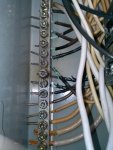rayalvarado
New member
- Location
- Rancho Cordova, CA
We did a service call on a home 120/240 single phase service.We found all the #14 gauge and #12 gauge neutral wires attached to the neutral bar in the meter main combo panel to be burnt. The larger gauge wires #10,#8 were discolored as well. They got really hot . Nothing was out of phase. All connections in the Panel were tight. The main breaker was tight. The breakers attached to the buss bar were tight. The service side connections were tight. the Meter was tight. The grounds were tight Everything in the panel was correct and tight.
It appears that the utility company may have lost a neutral leg, or one of the two hot legs got energized on the same phase at the same time from the utility.
Has anyone else experienced this before?
It appears that the utility company may have lost a neutral leg, or one of the two hot legs got energized on the same phase at the same time from the utility.
Has anyone else experienced this before?


